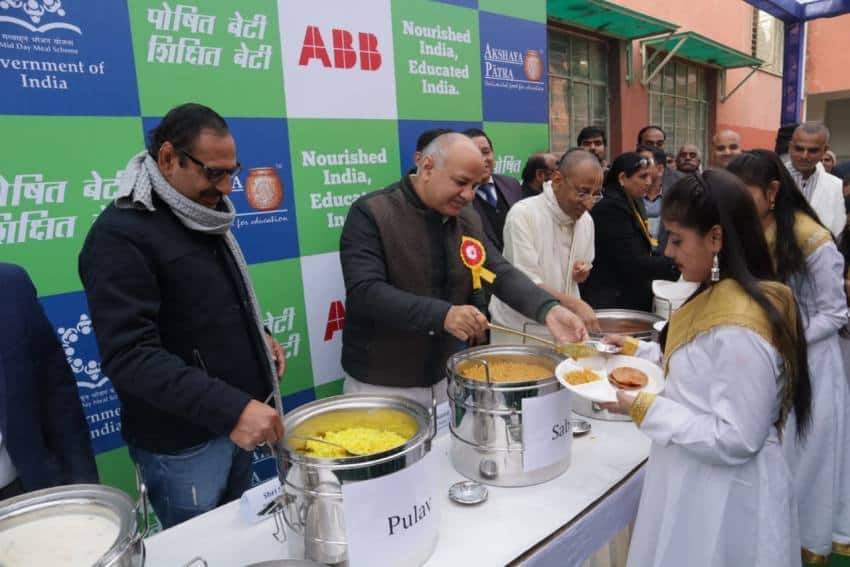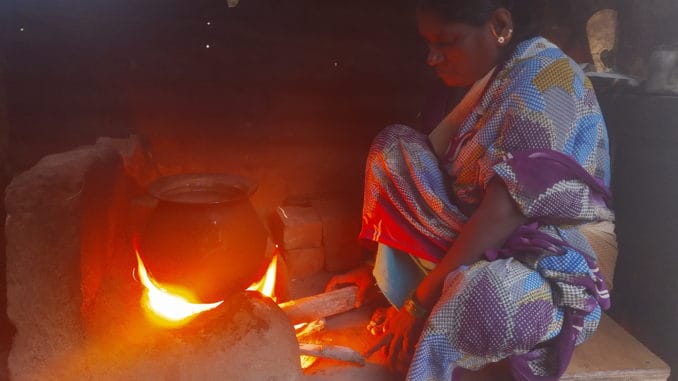On December 29th, Delhi Chief Minister Arvind Kejriwal and Deputy Chief Minister Manish Sisodia rolled out a scheme of supplying dry ration kits in lieu of the mid-day meals in east Delhi’s Mandawali area that falls in Sisodia’s assembly constituency of Patparganj. Each kit contained provisions for six months that included wheat, rice, pulses and oil. “During the lockdown, we tried to provide an allowance in place of the mid-day meals in the students’ bank accounts, but now we are starting distribution of dry-ration among students,” said Kejriwal.
Though the scheme will continue till the schools reopen, Sisodia confessed missing mid-day meals has hit children hugely. “Many families were finding it hard to put enough food on their plates,” said Sisodia. “Massive unemployment due to COVID-19 has aggravated the issue. It was the CM’s idea that it’s better to distribute ration rather than transfer money. Hence, we are now providing dry ration to more than eight lakh students in government and government-aided schools in Delhi.

Alarming deficit in nutrition
Food and nutrition expert Gopika Bhardwaj finds the malnutrition levels shocking given the overflowing godowns of foodgrains and the resultant wastage, even as children are ‘wasting’– which the WHO defines as having low weight for a given height. “It just means these children are not getting one wholesome meal a day,” says Gopika. “Khichdi in many parts, sambar-rice in other parts, it is such a simple dish that can prevent wasting. It is something that the government can give easily through community kitchens across the country, regardless of schools being open or not.”
Particularly affected are the very poor and the street children who can be seen asking for food at every major traffic signal, outside bus depots and metro stations and railway stations, temples and even tourist spots. Most hotels and restaurants, through their associations, pass on the leftovers to feed the poor, but they too have taken an unprecedented hit and have little to spare today. Attempts to provide dry rations is not reaching the people who need it most.
Read more: Delhi: Kids go hungry even as foodgrains rot in overflowing godowns
An Act in disuse
The Food Security Act, 2013 guarantees children in the 6-14 age group one mid-day meal free of charge every school day, in all schools run by local bodies, governments and government aided schools, so as to meet nutritional standards.
Interestingly, the law clearly guarantees (Chapter III, point 8) a food security allowance: “In case of non-supply of the entitled quantities of food grains or meals to the entitled persons, (under Chapter II), such persons shall be entitled to receive such food security allowance from the concerned state government to be paid to each person, within such time and manner as may be prescribed by the Central Government”. Food grains however, are defined as only rice, wheat or coarse grains, and does not include pulses.
“I think of the PDS more as a social security measure than as a nutrition intervention,” says economist Jean Dreze, known for his work on food, hunger and nutrition among Indian children. “As long as the PDS is restricted to food grains, it cannot be expected to have a major nutrition impact. Still, it has some value as a nutrition intervention, because the first step towards good nutrition is to avoid hunger, and the PDS is quite helpful in that respect,” he maintains.
In December 2019, Jean, a member of the National Advisory Committee in Dr Manmohan Singh’s regime and associated with the Right to Food campaign, had campaigned for inclusion of eggs in the mid-day meals in order to increase the level of proteins in the food.
Read more: Neither food nor food allowance for hungry school kids in Delhi since March (citizenmatters.in)
When ration card holders like Kriti, a domestic help, are facing nutritional issues, the nutritional value of food available to those living in her neighbourhood near the Ghazipur mandi who do not have a ration card is even more precarious. They are essentially labourers who came to the capital in search of a living with one or two children to feed, but are unemployed today. Whenever she can, the cook-cum-maid Kriti gives them 200-300 rupees, or feeds them along with her children.
“They cannot pay 25-30 rupees for a kilo of rice or atta,” says Kriti. “Families prefer women to work at their home—sweep, do the dishes and cook. But many of these women have very small children and I cannot ask them to take up work”. There is yet another family in her neighbourhood where the children are old enough to go to school, but cannot get admission as they don’t have an Aadhaar card. “If they get admission, then when schools reopen, at least one meal will be taken care of”.
Children of working mothers in the lower income groups have been impacted the most. With their mothers out at work from the crack of dawn, it is only those who have older relatives living with them that get a hot cooked meal for lunch. But most of these elderly relatives are now “back home” in Bihar or Uttar Pradesh.

Nutritional value
But while Kriti and most other mothers like her understand hunger, they understand little about the relationship between the food she puts on the plate and its nutritional value. The mid-day meal at school is calibrated to provide the required nutrition, free of charge.
The then Ministry of Human Resource Development (now, Education) Ministry, notified the Mid-Day Meal Rules 2015 under the National Food Security Act 2013, on September 30, 2015.
Foodgrains are defined as rice, wheat, coarse grains or any combination of them, and the meal as a hot cooked meal. Every child in the 6-14 age attending schools run by local bodies, government or government aided schools including madrasas and other similar institutions supported under the Sarva Shiksha Abhiyan, are eligible for the meal.
The nutrition content fixed under the scheme is 450 calories and 12 grams of proteins for children in the primary classes, and 700 calories and 20 grams of proteins for children in upper primary. A meal per child per day at the primary and upper primary levels is expected to include 100 and 150 grams respectively of food grains, 20 and 30 grams of pulses, 50 and 75 grams of vegetables, 5 and 7.5 grams of oil, and salt and condiments as needed.
The government periodically modifies the cost of cooking, transporting etc of the hot meals. But there has been no alteration in the caloric content or nutrients of the mid-day meals.
Underweight and stunted
“In India, malnutrition problem results not from calorie intake but from dependence on a carbohydrate-based diet low in protein and fat,” says dietician Mansi Chaudhary. She was reacting to an RTI reply from Delhi government’s Directorate of Economics and Statistics and the Office of the Chief Registrar of Births and Deaths in April 2019. It said the capital had seen 244 deaths due to malnutrition in hospitals, between 2013 and 2016: 66 of these in 2016.
Delhi has the highest percentage of severely stunted children (11.7%), according to the Urban Hunger and Malnutrition (HUNGaMA) study whose results were released in February 2018 by not-for-profit Naandi foundation. One in four urban children under the age of five is stunted (chronic malnutrition), the survey conducted in 10 of the country’s most populous cities found.
In a very elaborate earlier survey on the nutrition status of children across 100 ‘focus districts,’ HUNGaMA found 42 per cent of children under five to be underweight and 59 per cent stunted. Of the children suffering from stunting, about half are severely stunted. In the best district in each of these states, the rates of child wasting (underweight) and stunting were at 33 and 43 per cent respectively.
According to the 2020 Global Hunger Index Report, South Asia, which includes India, has the highest hunger and malnutrition levels among world regions, with 2020 GHI score of 26.0, which is considered serious.
India ranks 94. Pakistan at 88 and Bangladesh at 75 are better off! If we are to look for small mercies, the report classifies our condition as “serious”—as some countries like in sub Saharan Africa are classified as “alarming” and “extremely alarming” in terms of the level of hunger!
Also read:
What does the common Chennaiite eat when vegetables sell at Rs 80-100 a kilo? (citizenmatters.in)
Dharavi women take to street vending to feed families (citizenmatters.in)